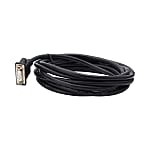(!) Since support from Microsoft will end on January 14 2020, Windows 7 user might not be able to use MISUMI website effectively. Please consider to update your system as ‘MISUMI Website system requirement’.
- แจ้งวันหยุดทำการในเดือน กรกฎาคมและสิงหาคม 2567 | Notice holiday in July and August 2024 > คลิก
MISUMI Stepping Motors(Control Method:Closed Loop)
MISUMI offers products Stepping Motors specified by Control Method Closed Loop from Automation Components product category. There are a total of 1 items. Search and select detailed specifications of parts for your machine with free CAD downloads. MISUMI products are available to order through MISUMI online 24 hours a day. Free shipping, no minimum order.
Configure
Specification/Dimensions
-
Type Details
- Motors
- Built-in Driver
- Single Driver
- Single Controller
- Motor Only
- Set
-
Square Flange Size A(mm)
-
Power Supply
-
Voltage Specifications
-
Control Method
- Open Loop
- Closed Loop
-
Step Angle(°)
-
Reducer
- Not Provided
- Provided
-
Drive Method
-
Backlash(°)
-
Holding torque (classification)(N·m)
- 0.1 or Less
- ~0.2
- ~0.3
- ~0.4
- ~0.5
- ~0.6
- ~0.7
- ~0.8
- ~0.9
- ~1
- ~1.1
- ~1.2
- ~1.3
- ~1.4
- ~1.5
- ~1.6
- ~1.7
- ~1.8
- ~1.9
- ~2
- ~3
- ~4
- ~5
- ~10
- ~15
- ~20
- ~30
- ~40
- ~60
* -0.2 represents > 0.1/≤ 0.2.
Brand |
|
|---|---|
| CAD |
|
- 1 items
- Sort By
-
Economy seriesYou can add up to 6 items per a category to the compare list.

From: ฿ 228.57 Days to Ship: Same day
Same day
| Brand |
|---|
| Product Series |
| From |
| Days to Ship |
| Type Details |
| Square Flange Size A(mm) |
| Power Supply |
| Voltage Specifications |
| Control Method |
| Step Angle(°) |
| Reducer |
| Drive Method |
| Backlash(°) |
| Holding torque (classification)(N·m) |
You can add up to 6 items per a category to the compare list. | |
| Brand | |
| Product Series | |
| From | ฿ 228.57 |
| Days to Ship | Same day |
| Type Details | - |
| Square Flange Size A(mm) | - |
| Power Supply | - |
| Voltage Specifications | - |
| Control Method | Closed Loop |
| Step Angle(°) | - |
| Reducer | - |
| Drive Method | - |
| Backlash(°) | - |
| Holding torque (classification)(N·m) | - |
Loading...
Application example related to this category
Related Categories to Stepping Motors
FAQ Stepping motor
- Question: For what purposes is a stepping motor typically utilized?
- Answer: Stepping motors are typically utilized in applications that require precise and accurate positioning, such as in robotics, automation systems, CNC machines, telescope mounts, and 3D printing. They are ideal for situations where the motor needs to move in small increments, rather than rotating continuously.
- Question: What are the differences between a stepping motor and a regular motor?
- Answer: The main difference between a stepping motor and a regular motor is that a stepping motor moves in small, precise steps, while a regular motor rotates continuously. Stepping motors are designed to move in discrete steps, making them ideal for applications that require precise positioning, whereas regular motors are designed to rotate continuously, making them ideal for applications that require continuous motion, such as driving a fan or a conveyor belt. Stepping motors also typically have higher torque at low speeds and are more expensive than regular motors.
- Question: Is a stepping motor categorized as AC or DC?
- Answer: Stepping motors can be categorized as either AC or DC depending on the type of motor. Some stepping motors are designed to operate on AC voltage, while others are designed to operate on DC voltage. However, the most common type of stepping motor used in industrial and commercial applications is the bipolar DC stepping motor. This type of motor is designed to operate on DC voltage and is widely used in robotics, automation systems, and other applications that require precise positioning.
- Question: What are some common applications for stepping motors, and what are the advantages of using them in these applications?
- Answer: Some common applications for stepping motors include robotics, automation systems, CNC machines, telescope mounts, and 3D printing. The advantages of using stepping motors in these applications include precise and accurate positioning, excellent repeatability, high torque at low speeds, and the ability to hold a position without power. These advantages make stepping motors ideal for applications that require precise control of movement and positioning.












How can we improve?
How can we improve?